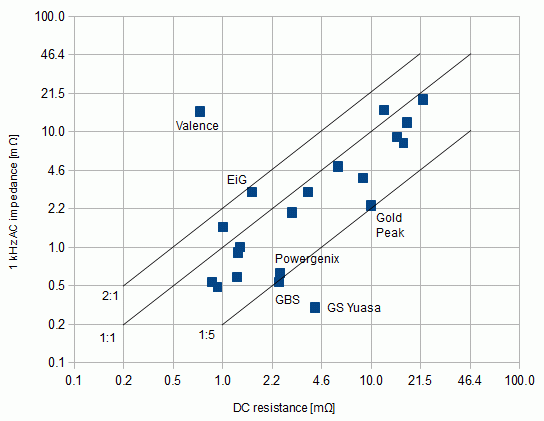 Li-Ion BMS
Li-Ion BMS
|
Home White Paper - Resistance vs impedance Cell impedance at 1 kHz is not the same as DC resistance 
IntroductionWhen cell manufacturers list resistance in their specs, they usually are talking about AC impedance at 1 kHz. Yet, what the user needs to know is the DC series resistance, because DC is what flows through the cells. Even though both are measured in mΩ, 1 kHz impedance and DC resistance are really different parameters. Manufacturers specify impedance at 1 kHz because:
Tha value of the cell's AC impedance is useless to the cell user. Reporting this value is entirely misleading to the user, who assumes it;s the value of the cell's DC resistance. The user need DC resistance because:
You can read more about this topic in section 1.2.7 of the book Battery Management Systems for Large Lithium-Ion Battery Packs . Data analysisCan you infer DC resistance from AC impedance? No, not really. However, if you look at data from many different cells, you can see some correlation. 
Impedance at 1 kHz vs DC resistance, for a variety of Li-ion cells It appears that, for most cells, the actual DC resistance value (at 50 % SOC, 25 °C) is within a range of 2:1 to 1:5 of the cell impedance impedance value reported by the manufacturer. That is a nice correlation. But, when you stop and think about it, it means that a cell that is specified to have a 1 mΩ AC impedance at 1 kHz, is likely (though not guaranteed) to have a DC resistance of anywhere between 0.5 and 5 mΩ. That is a full order of magnitude, and not very helpful to determine if a cell is appropriate for an application. Davide Andrea, Elithion, 1/23/13 | ||
© 2008~2025 Davide Andrea. All rights reserved, except where noted by CC mark. Page published on Jan 23 2013. Graphic design by morninglori